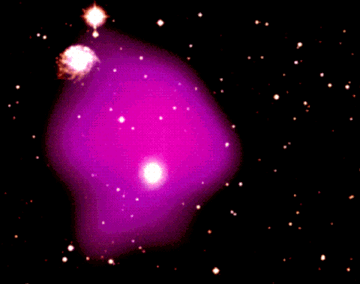In astronomy and cosmology, dark matter is a type of matter hypothesized to account for a large part of the total mass in the universe. Dark matter cannot be seen directly with telescopes; evidently it neither emits nor absorbs light or other electromagnetic radiation at any significant level.


Dark matter came to the attention of astrophysicists due to discrepancies between the mass of large astronomical objects determined from their gravitational effects, and mass calculated from the "luminous matter" they contain; such as stars, gas and dust. It was first postulated by Jan Oort in 1932 to account for the orbital velocities of stars in the Milky Way and Fritz Zwicky in 1933 to account for evidence of "missing mass" in the orbital velocities of galaxies in clusters. Subsequently, other observations have indicated the presence of dark matter in the universe, including the rotational speeds of galaxies, gravitational lensing of background objects by galaxy clusters such as the Bullet Cluster, and the temperature distribution of hot gas in galaxies and clusters of galaxies. According to consensus among cosmologists, dark matter is composed primarily of a new, not yet characterized, type of subatomic particle.

Dark matter's existence is inferred from gravitational effects on visible matter and gravitational lensing of background radiation, and was originally hypothesized to account for discrepancies between calculations of the mass of galaxies, clusters of galaxies and the entire universe made through dynamical and general relativistic means, and calculations based on the mass of the visible "luminous" matter these objects contain: stars and the gas and dust of the interstellar and intergalactic medium.
The most widely accepted explanation for these phenomena is that dark matter exists and that it is most likely composed of heavy particles that interact only through gravity and possibly the weak force; however, alternate explanations have been proposed, and there is not yet sufficient experimental evidence to determine which is correct. Many experiments to detect proposed dark matter particles through non-gravitational means are underway.
According to observations of structures larger than solar systems, as well as Big Bang cosmology interpreted under the Friedmann equations and the FLRW metric, dark matter accounts for 23% of the mass-energy content of the observable universe. In comparison, ordinary matter accounts for only 4.6% of the mass-energy content of the observable universe, with the remainder being attributable to dark energy. From these figures, dark matter constitutes 83%, (23/(23+4.6)), of the matter in the universe, whereas ordinary matter makes up only 17%.
Dark matter plays a central role in state-of-the-art modeling of structure formation and galaxy evolution, and has measurable effects on the anisotropies observed in the cosmic microwave background. All these lines of evidence suggest that galaxies, clusters of galaxies, and the universe as a whole contain far more matter than that which interacts with electromagnetic radiation.
As important as dark matter is thought to be in the cosmos, direct evidence of its existence and a concrete understanding of its nature have remained elusive. Though the theory of dark matter remains the most widely accepted theory to explain the anomalies in observed galactic rotation, some alternative theoretical approaches have been developed which broadly fall into the categories of modified gravitational laws and quantum gravitational laws.
0 comments:
Post a Comment